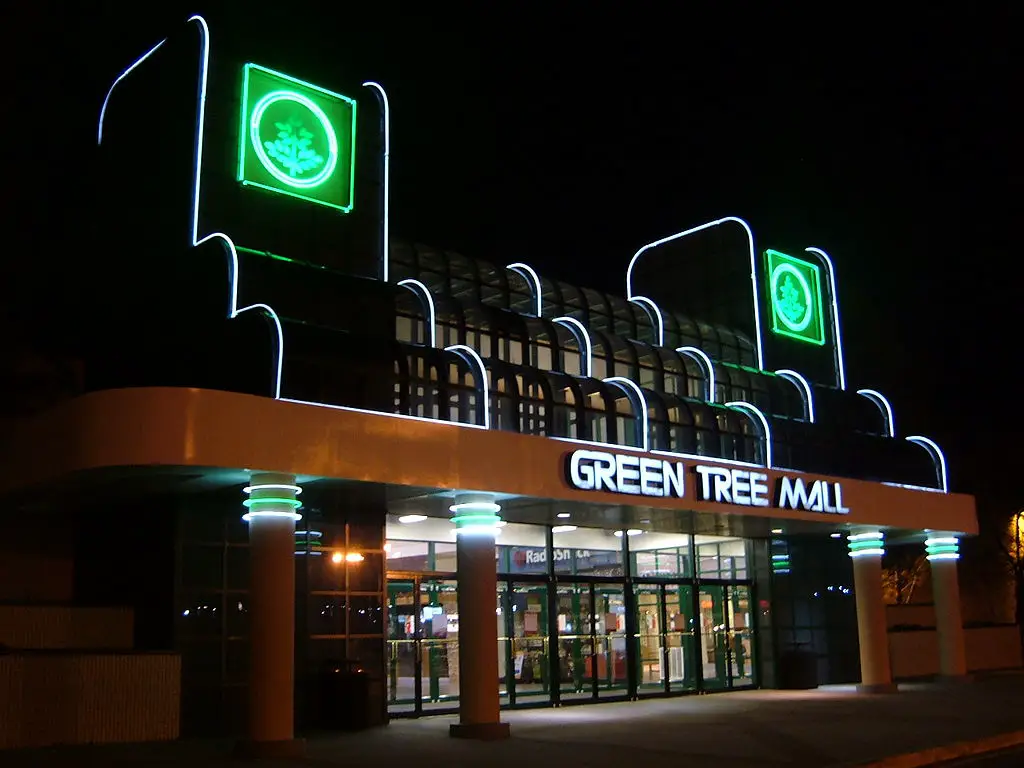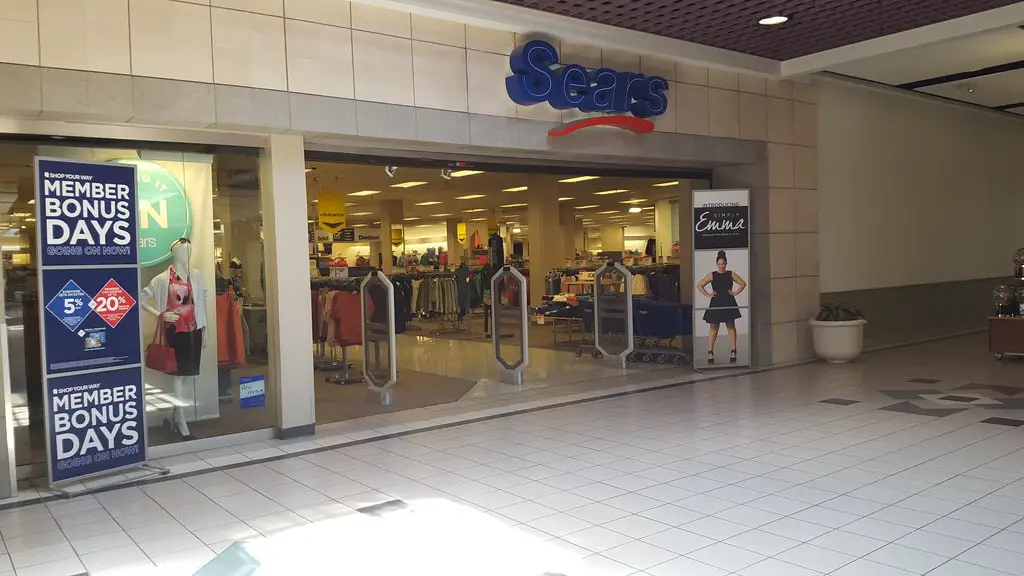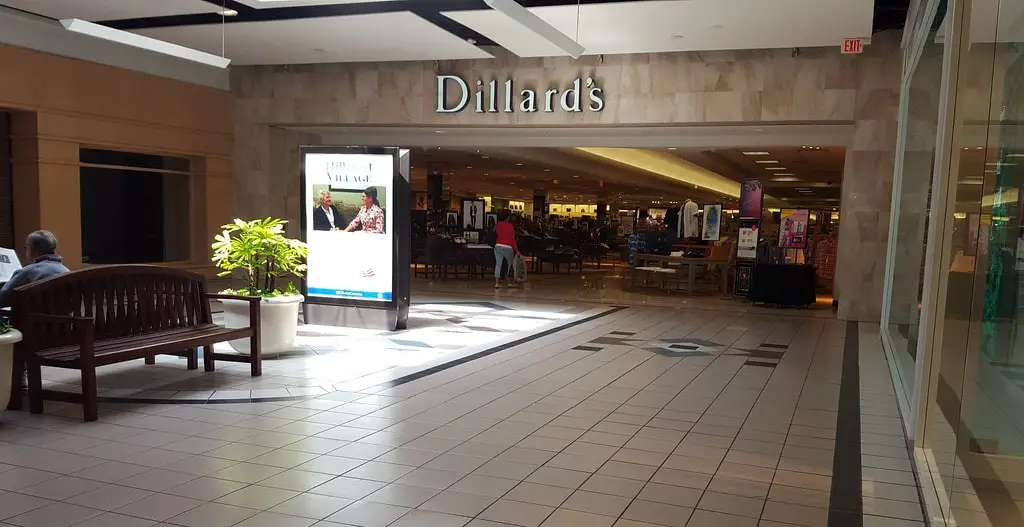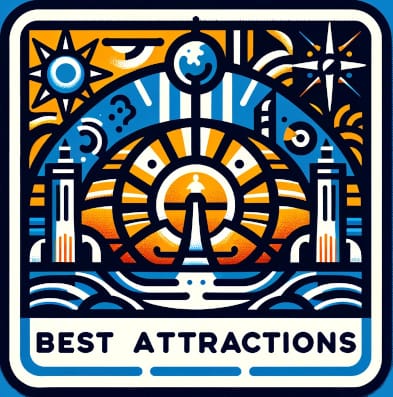The Inception and Early Years of Green Tree Mall
Introduction to Green Tree Mall
Green Tree Mall, a notable landmark in Clarksville, Indiana, opened its doors on December 24, 1968.
Situated conveniently off I-65, approximately four miles north of downtown Louisville, this mall emerged as a significant retail destination in the region.
Spanning a vast area of 793,800 square feet, it was designed to cater to a wide range of shopping preferences and quickly became a hub for residents and visitors.
Inspired by a large, aged boundary tree that once stood at its location, the mall’s name reflects its deep-rooted connection to the local community.
Early Anchors and Stores
The journey of Green Tree Mall began with the opening of a Sears department store on September 29, 1966, marking the first major retail establishment in the mall.
This was followed by adding other key stores, including JCPenney and a Danners dime store, further solidified the mall’s position as a retail powerhouse.
The developer, Roger Smith, played a crucial role in shaping the mall’s early identity, focusing on creating a diverse and appealing shopping environment.
These initial anchors and stores provided various products and services and set the stage for the mall’s future expansions and success.
Architectural Design and Initial Public Reception
The architectural design of Green Tree Mall was both functional and aesthetically pleasing, featuring a single-floor layout with a staff mezzanine in JCPenney.
This design facilitated easy navigation for shoppers and an enjoyable shopping experience. From its inception, the mall received a positive reception from the public, who were drawn to its convenient location, variety of stores, and modern design.
It quickly became a go-to destination for things to do in Louisville, Kentucky, attracting a steady flow of visitors eager to explore its retail offerings.
The mall’s early years were marked by a bustling atmosphere and a promising outlook, laying a strong foundation for its subsequent decades of operation.
Evolution and Expansion Over the Years
Major Additions and Departures
Green Tree Mall has experienced significant changes throughout its history, shaping its retail landscape.
A notable addition was the Texas Roadhouse restaurant, which opened its doors in 1993 and continues to operate, adding a dining dimension to the mall’s offerings.
The mall’s tenant mix changed significantly when Ben Snyder’s original anchor department store was replaced.
Following the acquisition by Hess’s, the space was transformed into a new store, creating a food court in the former Ben Snyder’s location.
However, this food court needed to meet expectations and was eventually repurposed, reflecting the mall’s adaptability to changing retail trends.

Ownership Changes
Ownership transitions have played a pivotal role in the mall’s evolution. 2013, the mall was sold to CBL Properties, marking a new chapter in its management and strategic direction.
Another significant transition followed this change in 2021 when Centennial Realty took over the mall’s management.
These shifts in ownership brought new perspectives and strategies to the mall’s operation, impacting its tenant mix, marketing approaches, and overall positioning in the retail market.
Community Engagement
Green Tree Mall has consistently engaged with the local community through various events and initiatives.
Club Mom, a monthly children’s entertainment event, became popular, fostering a family-friendly atmosphere.
Additionally, the mall hosted Kids Day, an event similar to Club Mom, further emphasizing its commitment to community involvement.
In 2007, Green Tree Mall was poised to become the inaugural Indiana venue for the Kentucky Derby Festival, featuring the U.S. Bank Derby Festival Great Balloonfest.
However, this event was canceled due to poor weather, demonstrating the mall’s ambition to be a key player in regional events.
The Rise and Fall of Anchor Stores
Sears as a Foundational Anchor
As one of the foundational anchors of Green Tree Mall, Sears played a crucial role in its initial success.
Even before the mall’s official launch, Sears attracted a significant customer base, contributing to the mall’s early popularity.
However, the shift in the retail landscape and the rise of online shopping led to challenges for Sears.
The store eventually closed on October 1, 2017, as part of a nationwide plan to shut down 43 stores.
This closure marked the end of an era for Green Tree Mall and substantially impacted its foot traffic and retail dynamics.

JCPenney and Dillard’s: Staying Power in Retail Shifts
JCPenney and Dillard’s have been constants in the ever-changing environment of Green Tree Mall.
JCPenney, one of the original anchors, has maintained its presence, adapting to the evolving retail market.
Dillard’s, which took over the Hess’s store, has remained a key anchor. Their ability to withstand the retail industry’s fluctuations has been vital to the mall’s stability, offering shoppers a diverse range of products and services.
Impact of Anchor Closures
The closure of Sears was a significant blow to Green Tree Mall, highlighting the challenges faced by traditional brick-and-mortar stores in the digital age.
This event underscored the vulnerability of malls to the loss of major tenants. The departure of such a significant anchor affected the mall’s foot traffic and raised concerns about the future viability of large retail spaces.
It signaled a critical point in the mall’s history, prompting a need for strategic rethinking to maintain relevance in a rapidly changing retail landscape.
Challenges and Decline
Economic and Retail Challenges
Like many traditional shopping centers, Green Tree Mall has faced significant challenges in the rapidly evolving retail landscape.
The emergence of online shopping and shifts in consumer tastes have presented significant challenges.
These shifts have decreased foot traffic and sales, impacting the mall’s profitability and appeal.
The economic downturns over the years further exacerbated these challenges, leading to a cautious consumer spending pattern and affecting the mall’s revenue streams.

Tenant Turnover and Vacancy Issues
The mall has experienced an increase in tenant turnover, with several stores closing or relocating.
This turnover has led to growing vacant spaces, altering the mall’s atmosphere and shopper experience.
The departure of key tenants and the difficulty in attracting new and relevant retailers has contributed to a perception of decline.
These vacancy issues have affected the mall’s aesthetics and ability to serve as a comprehensive shopping destination.
Perceptions of Decline
Public perception and media reports have increasingly labeled Green Tree Mall as a ‘dying mall.’
This perception has been fueled by the visible signs of decline, such as empty storefronts and reduced shopper numbers.
The narrative surrounding the mall’s struggles has further deterred potential tenants and shoppers, creating a cycle that challenges the mall’s revival efforts.
The mall’s management has faced the task of combating these negative perceptions while striving to revitalize the shopping center.
Current State and Tenant Mix
Overview of Current Tenants
As of December 2023, Green Tree Mall hosts diverse tenants. The current lineup includes major retail stores like American Eagle Outfitters, Bath & Body Works, and Victoria’s Secret.
Service-oriented businesses such as the United States Postal Service and Allstate Insurance also feature prominently.
The mall supports local businesses, including specialty stores like Punk Rags Boutique, Sunny Jewelers, and more.
This mix of national brands and local enterprises offers a varied shopping experience to visitors.

Recent Additions and Developments
In recent developments, Green Tree Mall welcomed Furniture Fair, occupying the space left vacant by Sears.
This addition marks a significant step in filling large empty spaces and diversifying the mall’s offerings.
This latest introduction indicates the management’s commitment to evolving with the current retail trends and catering to consumers’ changing tastes.
Analysis of Tenant Diversity and Appeal
The current tenant mix at Green Tree Mall reflects a strategic attempt to cater to a broad demographic.
The presence of well-known retail chains provides a sense of familiarity and reliability, while local businesses add a unique flavor to the mall’s character.
However, maintaining a tenant mix that can attract and retain a steady flow of visitors remains challenging.
The diversity of tenants is crucial in making the mall a destination for various shopping and service needs, enhancing its appeal in a competitive retail market.
Scale Trains at Green Tree Mall
Green Tree Mall in Clarksville, Indiana, has added an exciting attraction: a scale train exhibit titled “Trains at the Tree, Christmas 23.”
This event, organized by the Southern Indiana Railroad, was held in November and December 2023, adding a festive and engaging element to the mall’s holiday season.
The Southern Indiana Railroad presented their “Traveling” layout, a meticulously crafted 32 by 16 layout, next to the Furniture Fair store in the mall.
This exhibit showcased the newest modules of their scale train collection, drawing in enthusiasts and curious visitors alike.
The layout’s intricate design and detailed craftsmanship offered a fascinating glimpse into the world of model railroading.
The Southern Indiana Railroad Club members and special guests from local area model railroad organizations were present to run the trains, share information about the hobby, and engage with the public.
This event provided an excellent opportunity for individuals interested in model railroading to learn more about getting started in the world’s greatest hobby.
Scale trains in Green Tree Mall added a unique attraction and fostered community engagement and interest in a timeless hobby.
The Uncertain Future of Green Tree Mall
Reflecting on the Mall’s Journey
Green Tree Mall’s journey from a bustling shopping center to its current state is a narrative many traditional malls share.
It has experienced the highs of popularity and the lows of declining foot traffic and tenant vacancies.
This evolution reflects broader trends in the retail industry, where consumer preferences and technological advancements have reshaped the landscape.
Challenges in the Modern Retail Landscape
The challenges Green Tree Mall faces indicate the struggles within the brick-and-mortar retail sector.
The rise of e-commerce, changing consumer habits, and economic fluctuations have all altered the mall’s fortunes.
These challenges have necessitated rethinking the mall’s strategy and offerings to stay relevant and appealing to today’s consumers.
Future Outlook
The future of Green Tree Mall remains uncertain, but there is potential for transformation and renewal.
With strategic planning, innovative approaches, and community engagement, the mall could redefine itself as a modern, multi-purpose destination.
The success of these efforts will determine the mall’s fate and serve as a case study for the evolution of traditional shopping centers in an ever-changing retail environment.
Spring for a Getaway: Save 40% or more on hotels!


There are no electric carts for handicap shoppers so do not even try to shop there and spread the word so that others know. A definite sign of financial instability.
Thanks for highlighting the need for electric carts at Green Tree Mall. Shopping centers must be accessible to everyone, including those with mobility challenges.
Putting government service offices in malls would solve many problems. It would make access to government services more convenient to the public, reduce/eliminate vacant store space, and increase foot traffic.
Thanks for sharing your thoughts! Placing government offices in malls sounds like a win-win situation – more convenient access for the public and revitalization of mall areas.